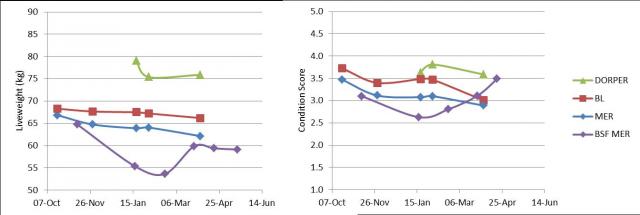Autumn stocktake at Katanning
Beth Paganoni, Nicola Stanwyck and Geoff Cox, Department of Agriculture and Food, Western Australia (DAFWA)
Corresponding author: Beth.Paganoni@agric.wa.gov.au
Autumn is pregnancy scanning time; a count of mouths to feed, a stock-take (literally). The Katanning Research Facility offers a benchmark to industry for many sheep performance measures, including reproduction.
There are two key research flocks at the facility; the genetic resource flock and the breech strike flock.
These two industry flocks are measured extensively for traits that are expensive and difficult to measure such as reproduction, meat quality and disease resistance.
The ewes and their progeny from both flocks have a full pedigree and have Australian Sheep Breeding Values registered with Sheep Genetics Australia.
Genetic resource flock - artificially inseminated
The genetic resource flock consists of 602 Merino and 330 Dorper mixed age ewes (3-6 years old) and 139 maiden Border Leicester ewes (3 years old).
Dorper ewes have been introduced to the genetic resource flock after a request from industry last year for their inclusion into our genetic benchmarking program. The Dorpers are managed and fed separately to the Merino and Border Leicester ewes.
The Merino and Border Leicester ewes were previously the information nucleus flock (INF). The genetic resource flock (previously INF) still has a sister flock based at the University of New England Kirby farm in Armidale, New South Wales.
The ewes are mated via artificial insemination to Merino and Terminal sires annually. All progeny generated from these flocks are measured for growth, muscle, fat and meat quality traits for the estimation of breeding values. Meat quality traits and abattoir information is collected by our research partner Murdoch University.
In 2017 ewes were mated via artificial insemination in early February to 156 sires from 72 industry studs. At mating, Merino ewes, on average, weighed 64 kilograms (kg) and had a condition score of 3.1. The Border Leicester ewes were slightly heavier with an average weight of 67kg and with a condition score of 3.5. The Dorper ewes were the heaviest of all three breeds, on average weighing 75kg with a condition score of 3.8 (Figure 1).
Ewes were scanned on 4 April 2017 and classed as zero (dries), single or twin pregnancies. Fertility (percentage of ewes pregnant) was highest for Border Leicester ewes (85%), followed by Merino (76%) and Dorpers (62%).
Reproductive rates (foetuses scanned per 100 ewes mated) were similar for Border Leicester and Merino ewes (134% and 128% respectively), but lower for Dorpers (98%). Hence, Merino ewes in a good body condition at joining can have a comparable reproductive performance to a maternal breed.
The lower reproductive performance of the Dorper ewes is probably due to the short period of adaptation on the farm prior to mating (approximately four weeks).

Breech strike flock – naturally mated
The breech strike flock consists of 900 mixed age Merino ewes (2-9 years old) that were sourced from the Mt Barker and Rylington Park Research Stations. All progeny generated from the natural mating of these ewes are measured for flystrike, worms, disease resistance, wrinkle and wool quality traits.
In 2017 the breech strike flock ewes were mated naturally to single sires (n=23) on small plots for 32 days (23 February to 27 March 2017). The ewes, on average, weighed 53.7kg with a condition score of 2.8 at mating (Figure 1). Ewes were scanned for pregnancy on 14 May 2017. Fertility (88%) and reproductive rate (147%) of the breech strike Merino ewes exceeded that of the Merino and non-Merino breeds of the genetic resource flock (Table 1). This is perhaps not surprising given they were naturally mated on small plots.
The percentage of rams to ewes across the 23 plots was approximately 2.5%. Two of the 23 sires were identified as performing poorly, with 70% of ewes on their respective plots being scanned as dry. The average proportion of dry ewes was only 6% when the results of these two sires were excluded.
| Mating type | Dorper (AI) | BL (AI) | MER (AI) | BSF MER (Natural) |
|---|---|---|---|---|
| Ewes scanned | 328 | 137 | 600 | 900 |
| Dries | 125 | 20 | 144 | 107 |
| Singles | 85 | 5 | 145 | 259 |
| Twins | 118 | 67 | 311 | 534 |
| Fertility (%) | 62 | 85 | 76 | 88 |
| Reproductive rate (%) | 68 | 134 | 128 | 147 |
With pregnancy scanning drawing to a close across the state, it is now time to do your own sums and see where your flock sits. Have you met your fertility and reproductive rate targets now that you know how many foetuses are on-board?
Calculating feed requirements for single and twin bearing ewes and feeding appropriate rations is wise, especially in average (or below-average) years as 2017 may be. DAFWA feed budget tools can assist in planning appropriate rations. The ‘Supplementary feed calculator for ewes on low green feed’ and ‘Feed cost calculator’ can be accessed within this website. Monitoring the condition score of ewes pre-lambing will also assist in maximising lamb survival, with condition score 3 being an optimum target for Merino ewes.
For more information about reproductive targets or pre-lambing management tips, contact Beth Paganoni, DAFWA South Perth, +61 (0)8 9368 3662.
Acknowledgements
These research flocks are both funded by DAFWA, and Meat and Livestock Australia (MLA) also provides funding for the genetic resource flock.

